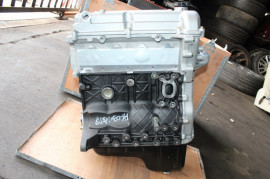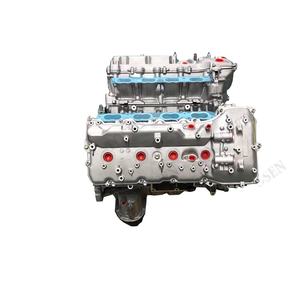Opel Corsa Engine: Common Issues and How to Take care of Them
Opel Corsa Engine: Common Issues and How to Take care of Them
Blog Article
Exploring the Inner Operation of a Compact Car's Engine System
As vehicle drivers, we often take for approved the intricate processes that occur within the confines of our car's engine system. In this expedition of a compact lorry's engine system, we will unwind the internal workings of this mechanical symphony, losing light on the mysteries that drive us forward on our everyday trips.
Combustion Refine Review
The burning process in a portable lorry's engine system is a crucial device that successfully transforms gas into energy to power the car. This procedure takes place within the burning chamber of the engine, where fuel and air mix, ignite, and create controlled explosions. The burning process contains 4 major phases: intake, exhaust, power, and compression.
Throughout the consumption stage, the piston relocates downward, reeling in a mixture of air and gas into the burning chamber. The following stage, compression, includes the piston moving up, compressing the air-fuel combination to enhance its effectiveness. Subsequently, in the power phase, the spark plug sparks the compressed blend, causing a quick expansion of gases that requires the piston pull back. This down activity generates the power required to drive the lorry. Lastly, in the exhaust phase, the burned gases are removed from the burning chamber via the exhaust valve, preparing the chamber for the next cycle. This cyclic burning procedure is basic to the operation of a portable vehicle's engine system, ensuring efficient energy conversion for propulsion.
Piston and Cyndrical Tube Communication

The piston's exact fit within the cylinder is vital for preserving ideal compression and protecting against power loss during combustion. Limited clearances in between the piston and cylinder walls ensure effective sealing, allowing the piston to relocate smoothly without enabling gases to leak past. Appropriate lubrication is likewise important to decrease friction and put on in between these elements, enhancing long life and efficiency.
Moreover, the style and materials used in manufacturing the piston and cyndrical tube impact engine efficiency and durability. Modern engines usually utilize light-weight yet resilient materials like light weight aluminum alloys for pistons and cyndrical tube liners to reduce inertia and boost thermal performance. In general, the unified interaction in between the piston and cyndrical tube is fundamental to the engine's functionality and total performance.
Gas Injection System Capability
Fuel injection systems in small vehicle engines play a crucial duty in exactly providing fuel to the burning chamber for controlled and effective ignition. The fuel injection system operates by injecting gas into the burning chamber at the optimum moment throughout the engine's operation (opel corsa engine). This exact timing ensures that the gas mixes equally with the air for appropriate burning, bring about enhanced gas effectiveness and lowered discharges
There are largely 2 kinds of gas shot systems utilized in portable car engines: port fuel shot (PFI) and direct fuel shot (DFI) PFI systems inject fuel right into the consumption port prior to the intake shutoff, while DFI systems infuse fuel directly into the burning chamber. Both systems have their benefits, with DFI offering better fuel atomization and PFI giving a more affordable option.
Comprehending Engine Air Conditioning Mechanisms
Efficient procedure of a small car's engine relies greatly on the performance of its cooling systems. The cooling system in a compact lorry generally consists of numerous elements working together to manage the engine temperature level. Recognizing these engine cooling mechanisms is important for maintaining the efficiency and longevity of a portable automobile's engine system.

Exhaust System Parts Explained
The optimal performance of a small vehicle's engine air conditioning mechanisms relies on a complementary system referred to as the exhaust system, which makes up various crucial components for making certain effective emissions and engine efficiency. The exhaust system includes components such as the exhaust manifold, catalytic converter, muffler, and tailpipe. The exhaust manifold collects exhaust gases from the engine's cyndrical tubes and paths them to the catalytic converter. The catalytic converter after that converts unsafe toxins discover this in the exhaust into much less dangerous emissions prior to releasing them through the muffler and tailpipe.
One crucial element of the exhaust system is the oxygen sensing unit, which monitors the oxygen levels in the exhaust gases to assist regulate fuel consumption and make sure optimal engine efficiency. opel corsa engine. Additionally, the resonator might be existing in some exhaust systems to decrease noise degrees. Generally, the exhaust system plays a vital function in keeping engine effectiveness, minimizing harmful discharges, and making sure a quieter driving experience for portable car proprietors

Verdict
In final thought, the compact automobile's engine system is an intricate combination of elements that function together to assist in the burning process, transform fuel right into power, and eliminate waste gases. Comprehending the internal operations of the engine system, including the piston and cyndrical tube interaction, fuel shot system, engine cooling systems, and exhaust system parts, is important for keeping optimum performance and efficiency of the car.
The burning procedure in a compact automobile's engine system is a crucial system that successfully transforms gas right into energy to power the car.Gas shot systems in compact vehicle engines play a vital duty in precisely providing fuel to the combustion chamber for reliable and controlled ignition.There are mainly two types of gas shot systems utilized in small automobile engines: port gas important link shot (PFI) and direct fuel injection (DFI) Understanding these engine air conditioning systems official source is important for maintaining the efficiency and long life of a portable vehicle's engine system.
The optimal performance of a portable automobile's engine air conditioning devices depends on a complementary system known as the exhaust system, which consists of various vital elements for guaranteeing efficient emissions and engine efficiency.
Report this page